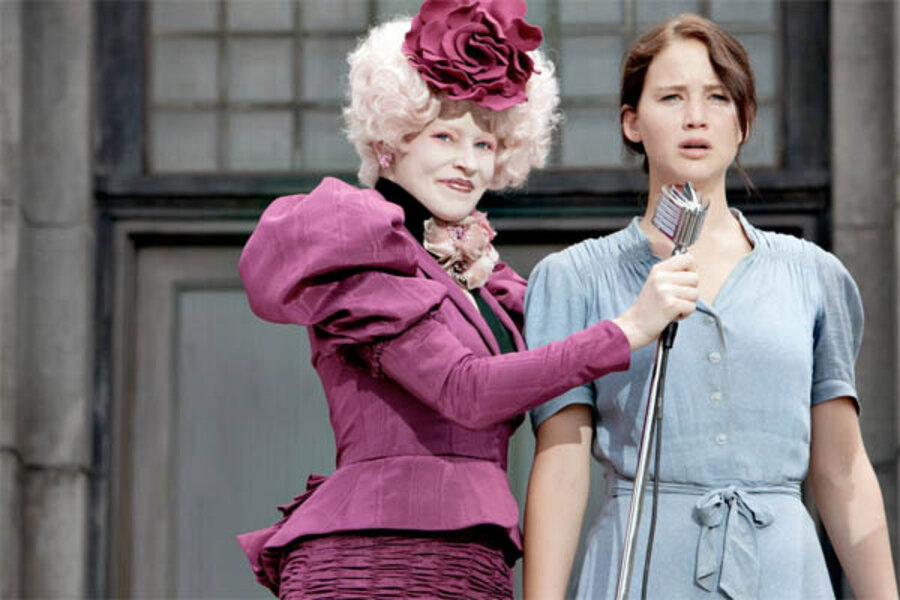'The Hunger Games': Is the violence acceptable?
Loading...
Children between the ages of 12 and 18 forced to kill each other in a large arena until only one of them is left standing.
It hardly sounds like an ideal story for pre-teens, or, depending on parental views, some early teens. But many parents may be making the choice soon whether to bring their children to the cineplex when “The Hunger Games,” the first installment of the dystopian young-adult trilogy about children taking part in a horrible reality show, arrives in theaters March 23. The movie is based on the book of the same name by Suzanne Collins, which is the first of a trilogy.
The book’s violence, in which many children and teenagers are killed, has been a hot topic since it was released. Star Jennifer Lawrence, who plays the heroine Katniss Everdeen in the film, was asked about the controversy after seven seconds of the film was cut to earn the movie a 12A rating in the UK, a rating that would allow children 12 and older in the theater, with younger children requiring an accompanying adult to gain entrance. In America, the movie is rated PG-13 for “intense violent thematic material and disturbing images, all involving teens."
Lawrence told Reuters she thought the violence was acceptable.
“It's the violence and the brutality (which) is the heart of the film, because it's what gets the people angry to start an uprising and to start a revolution,” she said. In the “Games” trilogy, it’s a corrupt government that forces the children to compete in the deadly Hunger Games.
“I do think the violence and brutality is justified,” Lawrence said. “But I understand if everybody has a different standard for ratings.”
Actor Josh Hutcherson said in an interview with Reuters that he believes the film strikes the right tone because it doesn’t glorify the violence taking place.
“I think kids are more mature than they have been over the years… It's not overly gruesome or brutal but it is part of the story in some way,” Hutcherson said.
The idea of kids being more mature is what seems to worry some parents, who think children will become desensitized to violence. In 2010, a New Hampshire mother, Tracy LaSalle, requested at a school board meeting that the first book be removed from her daughter’s seventh-grade classroom because she said her daughter had started having nightmares and that she worried the other children would become too used to the brutality described in the novel. The book was being read aloud in the classroom.
“Mrs. LaSalle stated there is no lesson in this book except if you are a teenager and kill twenty-three other teenagers, you win the game and your family wins,” the minutes from the meeting read, according to a School Library Journal article.
A school board member, Philip Pancoast, told the SLJ that he considers the book to be average young adult literature.
“A fair reading of ‘Old Yeller' would likely cause a child to have nightmares of the death of the dog,” Pancoast said.
If you’re a parent who’s wondering whether to take your child next weekend, a quick flip through the book may be the best bet. At the very least, know that the violent Games, in which children are encouraged to kill each other, is the center of the book (don’t read any further if you want to avoid spoilers)…
And all but two characters out of twenty-four die, some in very nasty ways. Many are killed immediately in the arena by others, and one character, who is 12 years old and whom the main character Katniss becomes attached to, dies after a spear is thrown into her abdomen. Others die from having their neck broken by a fellow teenager, having a rock smashed against their head by another teenager, and having a knife thrown at them by a competitor. One experiences a shudder-worthy fate when he’s attacked by wolves, unable to move after being shot by an arrow, and comes close to being eaten alive before the heroine shoots him out of pity. The heroine, Katniss, and her love interest each kill at least one person.
You may be sensing the word “Games” in the book is meant ironically.
On a discussion board on the website Goodreads, a user named Terrie who said she is a fourth-grade teacher wrote, “While I whipped through all three books in nothing flat, I was constantly aware of the extreme violence. I would even be hesitant to recommend these books to 5th graders, but maybe middle schoolers could handle them.”
Another user named Natalie said she read it to her sister when her sibling was nine years old and that there hadn’t been a problem.
“My brother (12) is reading Catching Fire now,” she wrote. “Certainly the child's maturity level comes into play, but I don't see why nine-year-olds wouldn't understand the novel.”
As for the film? A review by The Hollywood Reporter said, "It's also clear that the need for a PG-13 rating dictated moderation; a film accurately depicting the events of the book would certainly carry an R," seeming to imply that the events are at least a little toned down, though the review notes of the Games, "Quite a few [contestants] are butchered at the outset in the mad dash for weapons and supplies."
A Variety review seems to agree things are a little toned down, writing, "The PG-13 rating that ensures the film's suitability for its target audience also blunts the impact of the teen-on-teen bloodshed, most of it rendered in quick, oblique glimpses."
Check out a video of the stars of the movie discussing the violence below:
Molly Driscoll is a Monitor contributor.





